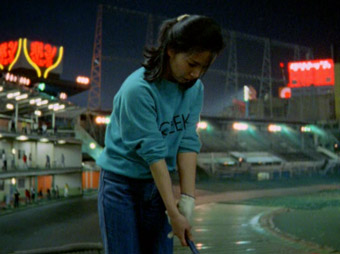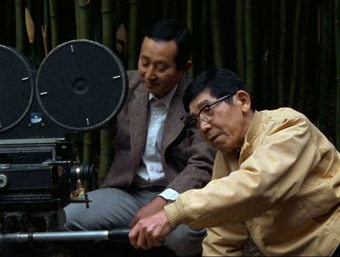|
In
1985, German director Wim Wenders, a huge admirer of the
cinema of Ozu Yasujirō (find me a major European director
who isn't), decided to visit Japan in search of the Tōkyō
of Ozu's films. In a city on the cutting edge of changing
times, how much of the Tōkyō of previous decades would remain?
Visiting Japan for the first time would also offer him the
chance to speak to two of Ozu's long-term collaborators
about working with the director, and hopefully reveal something
of his approach and methods.
I
cannot, simply cannot, take a detached and objective
view of Tokyo-Ga. As a confirmed Japanophile
and Ozu fan, I watched the film through the eyes
of a fellow passenger and revelled in details that may well go unnoticed or be considered insignificant by
others. I still vividly remember and treasure my first visit
to Japan and can't help but get a small thrill when I watch
others discover the unique wonder of the country for the
first time. But too often in the past we have been palmed
off with a whistle-stop tour of the aspects considered peculiar by the western visitor, which we were encouraged to regard through amused and sometimes mocking eyes. More recently, British
TV has taken a more considered and less frivolous approach
that I have personally welcomed – a particularly enjoyable
example had TV chef Rick Stein embark on his first visit
to the country to research his preparations for a meal for the Japanese Ambassador,
a trip that saw him delight at every aspect of eating there, a culinary
journey of discovery that fills me with empathic joy every
time I watch it (that I also have a serious thing for Japanese
cuisine only adds to the buzz here).

Such
a sympathetic approach was rare when Wenders embarked on
his inaugural visit back in 1985, and initially it might
seem that the director, who is seeing the city through a
newcomer's eyes, was fascinated by the very same things that
every reporter with a movie or video camera seems drawn
to. Thus we visit the Pachinko parlours and golf driving
ranges and watch the rock 'n' roll teens strutting their
stuff in Yoyogi Park. But where so many before and after have observed these same locations with almost comical
bemusement, Wenders approaches each with an open mind, a
sympathetic eye, and a determination to share and understand
the experience. He thus muses on the almost comforting trance
that a few hours spent in front of a Pachinko machine can
induce, the beauty of movement that proves more important
than accuracy on the driving range, and the significance of
camaraderie and sense of belonging that marks the rituals of the dancing
teenagers. His willingness to linger at each location for
longer than most reporters normally would enables him to
get past the common public perception and reveal something new in the
seemingly familiar, as with the 'nail man' who meticulously
checks each of the Pachinko machines after the parlour has
closed, or the male rockabilly teenagers making rare physical
contact in order to learn new dance steps.
Particularly
fascinating is the visit to one of the workshops responsible
for constructing the wax food models used by restaurants
to display their wares. If you've ever been to Japan you'll
have doubtless been struck by this culturally unique method
of promoting the menu within, with every dish on offer displayed
in the window as astonishingly lifelike wax models. It's
a disarmingly effective way of pulling you into a restaurant,
whose usually delicious cuisine will look almost exactly
like the model in the window that first charmed your taste buds,
something you can rarely say of the photographs in western
menus or on the backlit displays above fast food counters. Whether this sequence constitutes even a partial
answer to Wenders' original question is debatable, but it's
a captivating inclusion nonetheless.
A
high point for Ozu fans has to be the extended interviews
with Ryū Chishū, one of the director's most-used actors,
and regular cinematographer Atsuta Yūharu. Both men are
touchingly humble and even self-effacing about their own
achievements, crediting Ozu with the creativity and suggesting
that they merely did the best they could for a great artist.
Atsuta in particular supplies some intriguing information
about Ozu's approach to cinematography, and movingly recalls
his close friendship with the director, whose death has
left a hole in his life that moves him to tears and prompts him to
ask Wenders and his crew to leave him to his thoughts.
Wenders
clearly detects a steadily increasing American influence
on the country, a cultural globalisation that is being partially
embraced rather than fought against. He observes an irony
in TVs that are made in Japan to enable the world to watch
American images, but aborts a planned visit to the Tōkyō
Disneyworld at the last minute, uninterested in witnessing
an example of manufactured America on Japanese soil. This
struck a particular chord with me – two years ago I had
exactly the same response when taken to Universal City in
Ōsaka, whose surrounding arcade of mock Americana was hideous
and incongruous enough to dissuade me from entering the
park itself. That it was raining as heavily then as it is when
Wenders does his about-face only served to cement my sense
of empathy.

In Wenders' observations there is the suggestion that the Japan
depicted in Ozu's films, where family and community were
of paramount importance, is slowly disappearing, the modern
engagement with the Pachinko machine and the golf driving
range being seemingly solitary rather than communal activities.
While Ozu's old collaborators are observed in their traditional
houses, architectural symbols of a Japan of old, Tōkyō City
has become a concrete industrial sprawl, something Wenders'
friend and fellow filmmaker Werner Herzog looks down on
from Tōkyō Tower and despairs at. But it is important to
remember that Wenders' observations are still those of a
curious first-time visitor – dig beneath these examples
of surface escapism and the traditional values of Ozu's
Tōkyō are, at least in my experience, as solid as they ever
were. Only the sets are changing.
Then again, perhaps the dilution of Japanese culture is not
increasing at the rate that Wenders suspects. Twenty years
after Tokyo-Ga was made, I still recognise
the Japan depicted here as the one I only recently visited.
Indeed, one of the most striking aspects of the film is
that it is almost impossible to date from its content alone,
the only real giveaway being a brief sequence of kids playing
arcade games, where the crude graphics of Atari's Pole
Position have long since been replaced by machines
that require you to dance, play drums or, in games whose
popularity appears peculiar to Japan, go fishing.
It's
clear that not everyone will respond to Tokyo-Ga with my level of enthusiasm, but
for those less familiar with modern Japanese culture I would
still recommend it over any of the recent crop of American
features films that have used the country as a backdrop that is too often employed for the American leads to observe that things
there aren't like they are back home. And for those who
do know the country then it comes wholeheartedly recommended,
and I find myself in complete agreement with IMDb reviewer
weegeeworld who states simply, "Anyone in love with Japan should
see this film."
Shot
on 16mm and thus correctly framed at 1.33:1, there is visible
but not intrusive grain throughout and a slightly lower
level of detail than you'd get with 35mm, but otherwise
the transfer is up to the standard set by the other discs
in Anchor Bay's set, the colour and contrast being particularly
impressive on the neon signs of the night shots.

The
usual options of Dolby 2.0 mono of 5.1 surround are here,
and as with the other discs there is not much to chose between
them. The AC3 encoding throws the music a little wider,
but this is not a remix, and it all boils down to personal
preference or a coin flip.
Nothing
here. Again, the US release had a commentary, but...
I
have no doubt that some will complain about the unhurried
pace of Wenders' documentary, but it's that very quality
of sitting back and watching an activity for longer than
you would normally expect that makes Tokyo-Ga
so fascinating and insightful. I realise I'm talking from
a biased viewpoint here, but frankly couldn't care. This
is a fine documentary made by a filmmaker who takes the
time to understand and appreciate his subject, and in the
process he tells us almost as much about himself as he does
about Japan's vibrant capital.
|